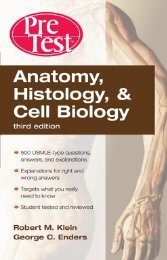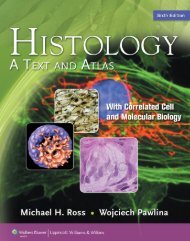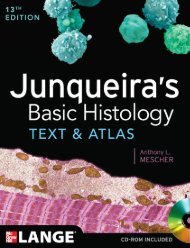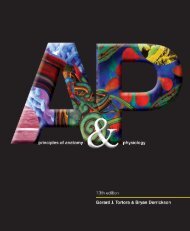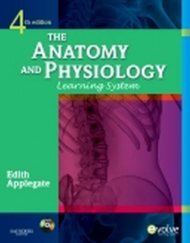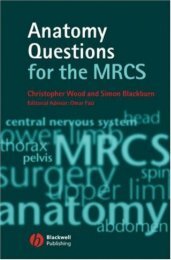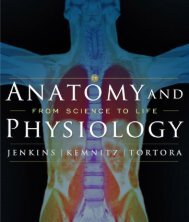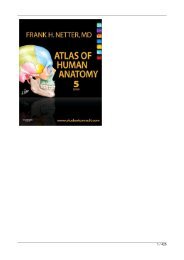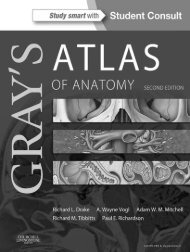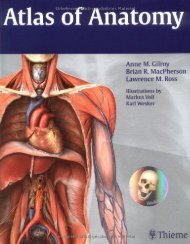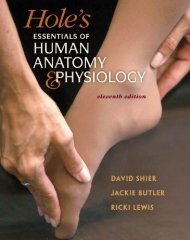urinalysis and body fluids
You also want an ePaper? Increase the reach of your titles
YUMPU automatically turns print PDFs into web optimized ePapers that Google loves.
©2008 F. A. Davis<br />
CHAPTER 1 • Safety in the Clinical Laboratory 3<br />
by the Centers for Disease Control <strong>and</strong> Prevention (CDC)<br />
<strong>and</strong> the Occupational Safety <strong>and</strong> Health Administration<br />
(OSHA) to prevent exposure. In 1987 the CDC instituted<br />
Universal Precautions (UP). Under UP all patients are considered<br />
to be possible carriers of blood-borne pathogens. The<br />
guideline recommends wearing gloves when collecting or<br />
h<strong>and</strong>ling blood <strong>and</strong> <strong>body</strong> <strong>fluids</strong> contaminated with blood <strong>and</strong><br />
wearing face shields when there is danger of blood splashing<br />
on mucous membranes <strong>and</strong> when disposing of all needles <strong>and</strong><br />
sharp objects in puncture-resistant containers. The CDC<br />
excluded urine <strong>and</strong> <strong>body</strong> <strong>fluids</strong> not visibly contaminated by<br />
blood from UP, although many specimens can contain a considerable<br />
amount of blood before it becomes visible. The<br />
modification of UP for <strong>body</strong> substance isolation (BSI) helped<br />
to alleviate this concern. BSI guidelines are not limited to<br />
blood-borne pathogens; they consider all <strong>body</strong> <strong>fluids</strong> <strong>and</strong><br />
moist <strong>body</strong> substances to be potentially infectious. According<br />
to BSI guidelines, personnel should wear gloves at all times<br />
when encountering moist <strong>body</strong> substances. A major disadvantage<br />
of BSI guidelines are that they do not recommend<br />
h<strong>and</strong>washing following removal of gloves unless visual contamination<br />
is present.<br />
In 1996 the CDC combined the major features of UP <strong>and</strong><br />
BSI guidelines <strong>and</strong> called the new guidelines St<strong>and</strong>ard Precautions.<br />
Although St<strong>and</strong>ard Precautions, as described below,<br />
stress patient contact, the principles most certainly can also<br />
be applied to h<strong>and</strong>ling patient specimens in the laboratory. 1<br />
St<strong>and</strong>ard Precautions are as follows:<br />
1. H<strong>and</strong>washing: Wash h<strong>and</strong>s after touching blood,<br />
<strong>body</strong> <strong>fluids</strong>, secretions, excretions, <strong>and</strong> contaminated<br />
items, whether or not gloves are worn. Wash h<strong>and</strong>s<br />
immediately after gloves are removed, between<br />
patient contacts, <strong>and</strong> when otherwise indicated to<br />
avoid transfer of microorganisms to other patients<br />
or environments. Washing h<strong>and</strong>s may be necessary<br />
between tasks <strong>and</strong> procedures on the same patient to<br />
prevent cross-contamination of different <strong>body</strong> sites.<br />
2. Gloves: Wear gloves (clean, nonsterile gloves are<br />
adequate) when touching blood, <strong>body</strong> <strong>fluids</strong>, secretions,<br />
excretions, <strong>and</strong> contaminated items. Put on<br />
gloves just before touching mucous membranes <strong>and</strong><br />
nonintact skin. Change gloves between tasks <strong>and</strong><br />
procedures on the same patient after contact with<br />
material that may contain a high concentration of<br />
microorganisms. Remove gloves promptly after use,<br />
before touching noncontaminated items <strong>and</strong> environmental<br />
surfaces, <strong>and</strong> before going to another patient.<br />
Always wash your h<strong>and</strong>s immediately after glove<br />
removal to avoid transfer of microorganisms to other<br />
patients or environments.<br />
3. Mask, eye protection, <strong>and</strong> face shield: Wear a mask<br />
<strong>and</strong> eye protection or a face shield to protect mucous<br />
membranes of the eyes, nose, <strong>and</strong> mouth during procedures<br />
<strong>and</strong> patient care activities that are likely to<br />
generate splashes or sprays of blood, <strong>body</strong> <strong>fluids</strong>,<br />
secretions, or excretions. A specially fitted respirator<br />
(N95) must be used during patient care activites<br />
related to suspected mycobacterium exposure.<br />
4. Gown: Wear a gown (a clean, nonsterile gown is adequate)<br />
to protect skin <strong>and</strong> to prevent soiling of clothing<br />
during procedures <strong>and</strong> patient care activities that<br />
are likely to generate splashes or sprays of blood,<br />
<strong>body</strong> <strong>fluids</strong>, secretions, or excretions. Select a gown<br />
that is appropriate for the activity <strong>and</strong> the amount of<br />
fluid likely to be encountered (e.g., fluid-resistant in<br />
the laboratory). Remove a soiled gown as promptly<br />
as possible, <strong>and</strong> wash h<strong>and</strong>s to avoid the transfer of<br />
microorganisms to other patients or environments.<br />
5. Patient care equipment: H<strong>and</strong>le used patient care<br />
equipment soiled with blood, <strong>body</strong> <strong>fluids</strong>, secretions,<br />
<strong>and</strong> excretions in a manner that prevents skin <strong>and</strong><br />
mucous membrane exposures, contamination of<br />
clothing, <strong>and</strong> transfer of microorganisms to other<br />
patients or environments. Ensure that reusable equipment<br />
is not used for the care of another patient until<br />
it has been cleaned <strong>and</strong> reprocessed appropriately.<br />
Ensure that single-use items are discarded properly.<br />
6. Environmental control: Ensure that the hospital has<br />
adequate procedures for the routine care, cleaning,<br />
<strong>and</strong> disinfection of environmental surfaces, beds,<br />
bedrails, bedside equipment, <strong>and</strong> other frequently<br />
touched surfaces. Ensure that these procedures are<br />
being followed.<br />
7. Linen: H<strong>and</strong>le, transport, <strong>and</strong> process linen soiled<br />
with blood, <strong>body</strong> <strong>fluids</strong>, secretions, <strong>and</strong> excretions in<br />
a manner that prevents skin <strong>and</strong> mucous membrane<br />
exposures <strong>and</strong> contamination of clothing <strong>and</strong> that<br />
avoids the transfer of microorganisms to other<br />
patients <strong>and</strong> environments.<br />
8. Occupational health <strong>and</strong> blood-borne pathogens:<br />
Take care to prevent injuries when using needles,<br />
scalpels, <strong>and</strong> other sharp instruments or devices;<br />
when h<strong>and</strong>ling sharp instruments after procedures;<br />
when cleaning used instruments; <strong>and</strong> when disposing<br />
of used needles. Never recap used needles or<br />
otherwise manipulate them using both h<strong>and</strong>s or use<br />
any other technique that involves directing the point<br />
of a needle toward any part of the <strong>body</strong>; rather, use<br />
self-sheathing needles or a mechanical device to conceal<br />
the needle. Do not remove used needles from<br />
disposable syringes by h<strong>and</strong>, <strong>and</strong> do not bend,<br />
break, or otherwise manipulate used needles by<br />
h<strong>and</strong>. Place used disposable syringes <strong>and</strong> needles,<br />
scalpel blades, <strong>and</strong> other sharp items in appropriate<br />
puncture-resistant containers, which are located as<br />
close as practical to the area in which the items were<br />
used, <strong>and</strong> place reusable syringes <strong>and</strong> needles in a<br />
puncture-resistant container for transport to the<br />
reprocessing area. Use mouthpieces, resuscitation<br />
bags, or other ventilation devices as an alternative




